About us ~ and about St George
All details about the clergy, the churchwardens, the congregation, and day-to-day administration of the parish can be found here
http://www.stgeorgeintheeast.org
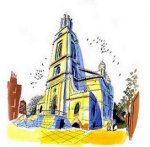
 Left: church,
with Rectory on the left, as depicted by Sarah
McMenemy for platform 2 of Shadwell Underground
Station on the East London Line, which re-opened on 27 April 2010 as
part of London Overground
Left: church,
with Rectory on the left, as depicted by Sarah
McMenemy for platform 2 of Shadwell Underground
Station on the East London Line, which re-opened on 27 April 2010 as
part of London Overground
Right: Church drawn in 1963 by John Piper CH
(1903-92), 21" x 13½" displayed as one of 39 goaches and watercolours
at the Hamet Gallery, London in 1969, when Terence Mullaly wrote'the romantic undertones recalling a stage backdrop are strong'
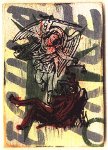 St George - our patron saint
St George - our patron saint
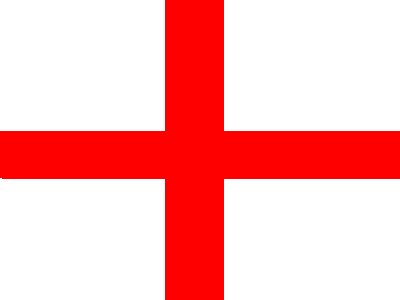 St George supplanted Edward the Confessor as the patron saint of
England in 1351, at the time of the Crusades. Many churches bear his name. The choice here was probably an
assertion of the authority of the established national church - though since the
area as well as the church took his name, there were St George's Churches of other
denominations (eg the German Lutheran and
Methodist churches).
St George supplanted Edward the Confessor as the patron saint of
England in 1351, at the time of the Crusades. Many churches bear his name. The choice here was probably an
assertion of the authority of the established national church - though since the
area as well as the church took his name, there were St George's Churches of other
denominations (eg the German Lutheran and
Methodist churches).
Who was he? Legends - perhaps about more than one person - abound,
making it hard to establish the facts. But we do know that from the 4th
century, in the Palestinian city of Lydda, they began to venerate a
Syrian soldier who had been a member of emperor Diocletian's guard and
had died for his faith under the emperor's persecutions. In the 6th
century someone wrote that he was a good man whose deeds are known only to God. He
came to be more widely honoured, as a soldier-saint, and the legends
began to develop - particularly, of course, that he slew a dragon.
So to treat him as an emblem of a particular kind of English
nationalism, as some political and other groups do, is fundamentally
misguided. He was not English, and is a patron saint all around the
world (in Russian Georgia, for instance, there are 365 churches bearing
his name).
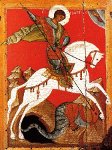
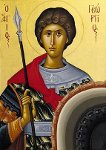
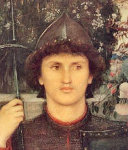
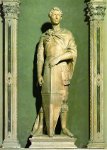
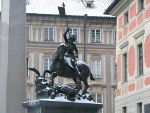

 Here
are some images from various places - Russian and Greek icons, a
European painting, Donatello's 15th-century marble statue in Florence,
a bronze statue in Prague, an Ethiopian image and a wooden statue from Latin America. See here for the 17th century Orthodox Church of St George at Puthupally, Kottayam in Kerala.
Here
are some images from various places - Russian and Greek icons, a
European painting, Donatello's 15th-century marble statue in Florence,
a bronze statue in Prague, an Ethiopian image and a wooden statue from Latin America. See here for the 17th century Orthodox Church of St George at Puthupally, Kottayam in Kerala.
Furthermore, there is a long tradition in the middle East of
veneration by Christians, Jews and Muslims together. He is therefore an
inclusive rather than an exclusive figure, and recent years have seen
attempts to recover this emphasis - especially relevant for a
multi-ethnic, multi-faith area such as that of St George-in-the-East.
 One example is the painting by Scott Norwood Witts, St George and Dead Soldier, which was displayed here in 2010 - pictured left; for more details, see here.
One example is the painting by Scott Norwood Witts, St George and Dead Soldier, which was displayed here in 2010 - pictured left; for more details, see here.
 Another is the Redcrosse project, taking its cue from Edmund Spenser's Faerie Queene, and
linking the cult of St George to the four elements of air, earth, fire
and water in a spiritual exploration of 'Englishness'. As part of the
project, Andrew Motion, the Poet Laureate, and others have produced a
'civic liturgy' for St George, asserting his inclusive nature. This was
presented at St George's Windsor and Manchester Cathedral (whose
dedication includes St George) around St George's Day 2011 (service
booklet here,
pages in 'folding'
order), with specially-composed music, and it is hoped that some of the
material will be more widely used; we have incorporated some of it into our
own patronal festivals. The 'merrie England' and 'four
elements' notes link with the original version of the rousing
'Hymn for St George and for Justice', a Christian Socialist favourite
whose original version began Dear patron saint of England, St George, our Lady's Knight, we ask your prayers and blessings to aid us in our fight, with the chorus Uplift St George's banner and let the ancient cry 'St George for Merrie England' re-echo to the sky (full text, in 'modernised' form, here). See here for its use in Fr Groser's time, here for an 1895 sermon by a predecessor on the revival of the cult of 'Merrie England', and here for the 'Thaxted tradition' that inspired Fr Groser and other clergy of our parish - and comments on flying various flags...
Another is the Redcrosse project, taking its cue from Edmund Spenser's Faerie Queene, and
linking the cult of St George to the four elements of air, earth, fire
and water in a spiritual exploration of 'Englishness'. As part of the
project, Andrew Motion, the Poet Laureate, and others have produced a
'civic liturgy' for St George, asserting his inclusive nature. This was
presented at St George's Windsor and Manchester Cathedral (whose
dedication includes St George) around St George's Day 2011 (service
booklet here,
pages in 'folding'
order), with specially-composed music, and it is hoped that some of the
material will be more widely used; we have incorporated some of it into our
own patronal festivals. The 'merrie England' and 'four
elements' notes link with the original version of the rousing
'Hymn for St George and for Justice', a Christian Socialist favourite
whose original version began Dear patron saint of England, St George, our Lady's Knight, we ask your prayers and blessings to aid us in our fight, with the chorus Uplift St George's banner and let the ancient cry 'St George for Merrie England' re-echo to the sky (full text, in 'modernised' form, here). See here for its use in Fr Groser's time, here for an 1895 sermon by a predecessor on the revival of the cult of 'Merrie England', and here for the 'Thaxted tradition' that inspired Fr Groser and other clergy of our parish - and comments on flying various flags...
Finally, do you remember the children's hymn When a knight won his spurs, by Jan Struther, still worth singing on St George's Day? We still have dragons to fight....
The Ramanoop family
 One
of the key families in our congregation are the Ramanoops:
ten brothers and sisters and their extended families, most of whom live
in East London, though even those who live abroad worship here from
time to time! Allan is one of our
churchwardens, and Annadale a PCC member and flower organiser. All but
the youngest came with their parents Joseph and Sarah from
Trinidad in the 1960s - they know how to grow and pick coffee beans! -
and settled in the area. Joe and Sarah are commemorated
with a tree in the churchyard. Joe [pictured], a Hindu but happy to attend
events at the family's church, was a Labour Councillor for St
Katharine's and Holy Trinity wards from 1974 until 1998 and Mayor of
Tower Hamlets from 1997-98, when he was made a freeman of the City of
London; he met various members of the royal family. He fought
passionately against racism until his death in 2003, and was
vice-president of the local Race Equality Council. In his latter years,
he was a well-known figure at the Providence Row day centre. After his
death, he
was nominated for a Trinity Cross in Trinidad in recognition of his
services to the community.
One
of the key families in our congregation are the Ramanoops:
ten brothers and sisters and their extended families, most of whom live
in East London, though even those who live abroad worship here from
time to time! Allan is one of our
churchwardens, and Annadale a PCC member and flower organiser. All but
the youngest came with their parents Joseph and Sarah from
Trinidad in the 1960s - they know how to grow and pick coffee beans! -
and settled in the area. Joe and Sarah are commemorated
with a tree in the churchyard. Joe [pictured], a Hindu but happy to attend
events at the family's church, was a Labour Councillor for St
Katharine's and Holy Trinity wards from 1974 until 1998 and Mayor of
Tower Hamlets from 1997-98, when he was made a freeman of the City of
London; he met various members of the royal family. He fought
passionately against racism until his death in 2003, and was
vice-president of the local Race Equality Council. In his latter years,
he was a well-known figure at the Providence Row day centre. After his
death, he
was nominated for a Trinity Cross in Trinidad in recognition of his
services to the community.
Samuel Doodnath, a relative in Trinidad (headteacher and licensed Reader) wrote several books about the family's background: A short history of the early Presbyterian Church and the Indian Immigrant in Trinidad 1845-1945 (1983), A short history of the East Indian progress in Trinidad and lives of famous Indians 1845-1984 (1985), From India to Trinidad (1987), Reminiscences of India and early Trinidad by an immigrant family (1995), plus Indian Prince and Chinese Princess in Love (1995).
The Parish Clerk
 Nowadays this is an honorary office. In the past, as you can
see from various history pages on this site (for example, here and here) the clerk - another ancient office - was a key, and hard-working, administrator. These days have gone, but in London the Worshipful Company of Parish Clerks
(founded in 1635/6) survives, with a distinguished history, and we are
one of the 150 or so parishes - though not one of those on the original
list - entitled to nominate a member. Ronald Guy Ellen A London Steeplechase
(City Press 1972, out of print) details all the parishes. [Our current
clerk is Geoffrey Tattersall QC [pictured], a barrister, judge and diocesan Chancellor who worships
with us whenever he is in London.]
Nowadays this is an honorary office. In the past, as you can
see from various history pages on this site (for example, here and here) the clerk - another ancient office - was a key, and hard-working, administrator. These days have gone, but in London the Worshipful Company of Parish Clerks
(founded in 1635/6) survives, with a distinguished history, and we are
one of the 150 or so parishes - though not one of those on the original
list - entitled to nominate a member. Ronald Guy Ellen A London Steeplechase
(City Press 1972, out of print) details all the parishes. [Our current
clerk is Geoffrey Tattersall QC [pictured], a barrister, judge and diocesan Chancellor who worships
with us whenever he is in London.]
Homepage | About Us | Services & Events
| Church &
Churchyard |
History
Newsletters & Sermons | Contacts,
Links & Registers | Giving | Picture
Gallery |
Site Map


 Left: church,
with Rectory on the left, as depicted by Sarah
McMenemy for platform 2 of Shadwell Underground
Station on the East London Line, which re-opened on 27 April 2010 as
part of London Overground
Left: church,
with Rectory on the left, as depicted by Sarah
McMenemy for platform 2 of Shadwell Underground
Station on the East London Line, which re-opened on 27 April 2010 as
part of London Overground St George - our patron saint
St George - our patron saint St George supplanted Edward the Confessor as the patron saint of
England in 1351, at the time of the Crusades. Many churches bear his name. The choice here was probably an
assertion of the authority of the established national church - though since the
area as well as the church took his name, there were St George's Churches of other
denominations (eg the German Lutheran and
Methodist churches).
St George supplanted Edward the Confessor as the patron saint of
England in 1351, at the time of the Crusades. Many churches bear his name. The choice here was probably an
assertion of the authority of the established national church - though since the
area as well as the church took his name, there were St George's Churches of other
denominations (eg the German Lutheran and
Methodist churches). 




 Here
are some images from various places - Russian and Greek icons, a
European painting, Donatello's 15th-century marble statue in Florence,
a bronze statue in Prague, an Ethiopian image and a wooden statue from Latin America. See here for the 17th century Orthodox Church of St George at Puthupally, Kottayam in Kerala.
Here
are some images from various places - Russian and Greek icons, a
European painting, Donatello's 15th-century marble statue in Florence,
a bronze statue in Prague, an Ethiopian image and a wooden statue from Latin America. See here for the 17th century Orthodox Church of St George at Puthupally, Kottayam in Kerala. One example is the painting by Scott Norwood Witts, St George and Dead Soldier, which was displayed here in 2010 - pictured left; for more details, see here.
One example is the painting by Scott Norwood Witts, St George and Dead Soldier, which was displayed here in 2010 - pictured left; for more details, see here. Another is the Redcrosse project, taking its cue from Edmund Spenser's Faerie Queene, and
linking the cult of St George to the four elements of air, earth, fire
and water in a spiritual exploration of 'Englishness'. As part of the
project, Andrew Motion, the Poet Laureate, and others have produced a
'civic liturgy' for St George, asserting his inclusive nature. This was
presented at St George's Windsor and Manchester Cathedral (whose
dedication includes St George) around St George's Day 2011 (service
booklet here,
pages in 'folding'
order), with specially-composed music, and it is hoped that some of the
material will be more widely used; we have incorporated some of it into our
own patronal festivals. The 'merrie England' and 'four
elements' notes link with the original version of the rousing
'Hymn for St George and for Justice', a Christian Socialist favourite
whose original version began Dear patron saint of England, St George, our Lady's Knight, we ask your prayers and blessings to aid us in our fight, with the chorus Uplift St George's banner and let the ancient cry 'St George for Merrie England' re-echo to the sky (full text, in 'modernised' form, here). See here for its use in Fr Groser's time, here for an 1895 sermon by a predecessor on the revival of the cult of 'Merrie England', and here for the 'Thaxted tradition' that inspired Fr Groser and other clergy of our parish - and comments on flying various flags...
Another is the Redcrosse project, taking its cue from Edmund Spenser's Faerie Queene, and
linking the cult of St George to the four elements of air, earth, fire
and water in a spiritual exploration of 'Englishness'. As part of the
project, Andrew Motion, the Poet Laureate, and others have produced a
'civic liturgy' for St George, asserting his inclusive nature. This was
presented at St George's Windsor and Manchester Cathedral (whose
dedication includes St George) around St George's Day 2011 (service
booklet here,
pages in 'folding'
order), with specially-composed music, and it is hoped that some of the
material will be more widely used; we have incorporated some of it into our
own patronal festivals. The 'merrie England' and 'four
elements' notes link with the original version of the rousing
'Hymn for St George and for Justice', a Christian Socialist favourite
whose original version began Dear patron saint of England, St George, our Lady's Knight, we ask your prayers and blessings to aid us in our fight, with the chorus Uplift St George's banner and let the ancient cry 'St George for Merrie England' re-echo to the sky (full text, in 'modernised' form, here). See here for its use in Fr Groser's time, here for an 1895 sermon by a predecessor on the revival of the cult of 'Merrie England', and here for the 'Thaxted tradition' that inspired Fr Groser and other clergy of our parish - and comments on flying various flags... One
of the key families in our congregation are the Ramanoops:
ten brothers and sisters and their extended families, most of whom live
in East London, though even those who live abroad worship here from
time to time! Allan is one of our
churchwardens, and Annadale a PCC member and flower organiser. All but
the youngest came with their parents Joseph and Sarah from
Trinidad in the 1960s - they know how to grow and pick coffee beans! -
and settled in the area. Joe and Sarah are commemorated
with a tree in the churchyard. Joe [pictured], a Hindu but happy to attend
events at the family's church, was a Labour Councillor for St
Katharine's and Holy Trinity wards from 1974 until 1998 and Mayor of
Tower Hamlets from 1997-98, when he was made a freeman of the City of
London; he met various members of the royal family. He fought
passionately against racism until his death in 2003, and was
vice-president of the local Race Equality Council. In his latter years,
he was a well-known figure at the Providence Row day centre. After his
death, he
was nominated for a Trinity Cross in Trinidad in recognition of his
services to the community.
One
of the key families in our congregation are the Ramanoops:
ten brothers and sisters and their extended families, most of whom live
in East London, though even those who live abroad worship here from
time to time! Allan is one of our
churchwardens, and Annadale a PCC member and flower organiser. All but
the youngest came with their parents Joseph and Sarah from
Trinidad in the 1960s - they know how to grow and pick coffee beans! -
and settled in the area. Joe and Sarah are commemorated
with a tree in the churchyard. Joe [pictured], a Hindu but happy to attend
events at the family's church, was a Labour Councillor for St
Katharine's and Holy Trinity wards from 1974 until 1998 and Mayor of
Tower Hamlets from 1997-98, when he was made a freeman of the City of
London; he met various members of the royal family. He fought
passionately against racism until his death in 2003, and was
vice-president of the local Race Equality Council. In his latter years,
he was a well-known figure at the Providence Row day centre. After his
death, he
was nominated for a Trinity Cross in Trinidad in recognition of his
services to the community.  Nowadays this is an honorary office. In the past, as you can
see from various history pages on this site (for example, here and here) the clerk - another ancient office - was a key, and hard-working, administrator. These days have gone, but in London the Worshipful Company of Parish Clerks
(founded in 1635/6) survives, with a distinguished history, and we are
one of the 150 or so parishes - though not one of those on the original
list - entitled to nominate a member. Ronald Guy Ellen A London Steeplechase
(City Press 1972, out of print) details all the parishes. [Our current
clerk is Geoffrey Tattersall QC [pictured], a barrister, judge and diocesan Chancellor who worships
with us whenever he is in London.]
Nowadays this is an honorary office. In the past, as you can
see from various history pages on this site (for example, here and here) the clerk - another ancient office - was a key, and hard-working, administrator. These days have gone, but in London the Worshipful Company of Parish Clerks
(founded in 1635/6) survives, with a distinguished history, and we are
one of the 150 or so parishes - though not one of those on the original
list - entitled to nominate a member. Ronald Guy Ellen A London Steeplechase
(City Press 1972, out of print) details all the parishes. [Our current
clerk is Geoffrey Tattersall QC [pictured], a barrister, judge and diocesan Chancellor who worships
with us whenever he is in London.]